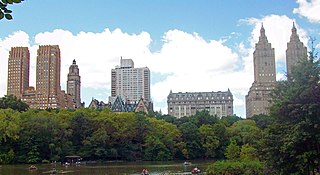
An apartment, flat, or unit is a self-contained housing unit that occupies part of a building, generally on a single storey. There are many names for these overall buildings. The housing tenure of apartments also varies considerably, from large-scale public housing, to owner occupancy within what is legally a condominium, to tenants renting from a private landlord.

A condominium is an ownership regime in which a building is divided into multiple units that are either each separately owned, or owned in common with exclusive rights of occupation by individual owners. These individual units are surrounded by common areas that are jointly owned and managed by the owners of the units. The term can be applied to the building or complex itself, and is sometimes applied to individual units. The term "condominium" is mostly used in the US and Canada, but similar arrangements are used in many other countries under different names.

A housing cooperative, or housing co-op, is a legal entity, usually a cooperative or a corporation, which owns real estate, consisting of one or more residential buildings; it is one type of housing tenure. Typically housing cooperatives are owned by shareholders but in some cases they can be owned by a non-profit organization. They are a distinctive form of home ownership that have many characteristics that differ from other residential arrangements such as single family home ownership, condominiums and renting.

Olympic Tower is a 51-story, 620 ft-tall (190 m) building at 641 and 645 Fifth Avenue, between 51st and 52nd Streets, in the Midtown Manhattan neighborhood of New York City. Designed by Skidmore, Owings & Merrill (SOM), the mixed-use development contains condominium apartments, office space, and retail shops. The tower is named after Olympic Airways, whose president Aristotle Onassis jointly developed the tower with the Arlen Realty and Development Corporation between 1971 and 1974. It was the first skyscraper to be constructed within a special zoning district to encourage retail and mixed-use development along Fifth Avenue.
Gerald Guterman is an international real estate developer and investor. He is one of the largest multi-family apartment owner/operators and condominium converters in the United States, converting through 2017, 16,028 rental apartments to cooperative and condominium ownership throughout the United States. He also served as Operations Adviser to the Minister of Privatization, Government of Romania; Chairman, Committee on Romanian Banking & Finance Operations, United States Center for Strategic and International Studies, Washington, DC; Co-Chairman, Committee for Romanian Enterprise Development and Operations, United States Center for Strategic and International Studies, Washington, DC; Operations Advisor to the Interior Minister, Government of Austria; Operations and Financial Advisor to the President, Government of Romania. He is currently the chairman and CEO of Guterman Partners, LLC.

Multifamily residential, also known as multidwelling unit (MDU)) is a classification of housing where multiple separate housing units for residential inhabitants are contained within one building or several buildings within one complex. Units can be next to each other (side-by-side units), or stacked on top of each other (top and bottom units). Common forms include apartment building and condominium, where typically the units are owned individually rather than leased from a single building owner. Many intentional communities incorporate multifamily residences, such as in cohousing projects.
A flip tax is a fee paid by a seller or buyer on a housing co-op transaction, typically in New York City. It is not a tax and is not deductible as a property tax. It is a transfer fee, payable upon the sale of an apartment to the co-op.

The Corinthian is a 57-story apartment building at 330 East 38th Street in Murray Hill, Manhattan, New York City. It was New York City's largest apartment building when it opened in 1988.

The Apthorp is a condominium building at 2201–2219 Broadway on the Upper West Side of Manhattan in New York City, United States. The 12-story structure was designed by Clinton & Russell in the Italian Renaissance Revival style and occupies the full block between Broadway, West End Avenue, and West 78th and 79th Streets. It was built between 1905 and 1908 as a residential hotel by William Waldorf Astor, who named it after the Apthorp Farm, of which the site used to be part. The Apthorp is a New York City designated landmark and is listed on the National Register of Historic Places.

Louis Myerberg Dubin is a fourth-generation real estate developer who develops upscale condominiums, typically in large east-coast United States cities. He is a founding partner of Redbrick LMD, an opportunistic real estate investment and developments company headquartered in Washington, D.C. His former New York based firm Athena often sold condominiums to middle and upper-middle class buyers. His firm converted landmark buildings into luxury condominiums, one of which was bought by Charles Bronfman. He designed buildings to feature art by artist-sculptors such as Jonathan Cramer. He was described by New York Magazine as being one of the "new generation of uptown A-listers".

The Belnord is a condominium building at 225 West 86th Street on the Upper West Side of Manhattan in New York City. The 13-story structure was designed by Hiss and Weekes in the Italian Renaissance Revival style and occupies the full block between Broadway, Amsterdam Avenue, and 86th and 87th Streets. It was built between 1908 and 1909 by a syndicate of investors as a rental apartment building. The Belnord is a New York City designated landmark and is listed on the National Register of Historic Places.

1049 Fifth Avenue is a 23-floor luxury condominium apartment building located in the Upper East Side, New York City. Built in 1928 as the Adams Hotel, the building underwent extensive renovation in its conversion to residential condominiums during the years 1990-1993. When the apartments were first offered for sale in 1991, they were the highest-priced residential apartments ever listed in New York City. Their sale prices set city records in 1993 and 1994.

Adam Leitman Bailey is an American lawyer who practices residential and commercial real estate law as founder of Adam Leitman Bailey, P.C. He was involved in several notable legal cases.
Ugo Colombo is an Italian-born residential and commercial real estate developer in Miami, Florida.
David Bistricer is a New York-based real estate developer and the founder and principal of Clipper Equity. His firm focuses on the conversion of non-residential buildings to residential uses. One of Bistricer's latest ventures, in partnership with Chetrit Group, is the transformation of the shuttered four-building Cabrini Medical Center at 220 and 230 East 20th Street and 215 and 225 East 19th Street into a residential a condo project, Gramercy Square, with 223 units. The Woods Bagot-designed development features a different style for each property: a modern, a prewar, a boutique and a tower building. It also has about 38,000 square feet of amenities including a 75' sky-lit pool, a gym, a theater, a meditation room exclusively programmed by MNDFL and a wine cellar. And there's ample green space with a courtyard, a greenhouse and landscaping around the buildings.
Henry Moskowitz was a New York-based real estate investor and founder of the real estate management company The Argo Corporation. He also built and owned hotels in Israel.
Real estate is property consisting of land and the buildings on it, along with its natural resources such as growing crops, minerals or water, and wild animals; immovable property of this nature; an interest vested in this (also) an item of real property, buildings or housing in general. In terms of law, real relates to land property and is different from personal property while estate means the "interest" a person has in that land property.

The Gainsborough Studios, also known as 222 Central Park South, is a residential building on Central Park South, just east of Columbus Circle, in Midtown Manhattan, New York City. Designed by Charles W. Buckham, the building is 16 stories tall with 34 apartments. Named after English painter Thomas Gainsborough, the building is one of several in Manhattan that were built in the early 20th century as both studios and residences for artists.

75 Wall Street is a 43-story mixed-use building in the Financial District of Lower Manhattan in New York City. It contains Hyatt Centric Wall Street New York, a hotel with 253 rooms managed by Blue Sky Hospitality.














